Nintendogs Walkthrough
Awwww, puppies! GameSpot's beginner's guide to Nintendogs will get you up and running with your four-legged friend, and give you tips on training and competitions as well.
Design: Collin Oguro
Well, Nintendogs is here at last, and it's tearing up the sales charts. This free-form pet simulator can be quite addictive if you're into raising virtual puppies, but it can also be a bit confusing at first, as you're kind of thrown into the rigors of pet ownership without much of an introduction to how the game works.
GameSpot's Game Guide to Nintendogs is intended to be a basic introduction to the principals of Nintendogs, focusing on the three main types of competition, the process of teaching your dog tricks, and what can happen when you take it out for a walk. We'll cover the parts of the game that you may have questions about when you first boot it up; if you're looking for more in-depth coverage of all of the aspects of Nintendogs, then you might also want to check out the Nintendogs page on
Trick List
One of the primary tasks in Nintendogs is to teach your dog as many tricks as its little brain can hold. Doing so is a relatively easy process, at least when compared to dogs in the real world; if you can figure out how to touch your dog to encourage it to perform certain animations, then all you need to do is tap the trick button in the upper-right corner of the screen and say the name of the trick into the microphone.
If done correctly, you should see a number of yellow bulbs go off above your dog's head; this indicates that they registered the voice command. Note that you don't need to use a voice command that necessarily corresponds to what the trick actually is; you can even use nonsense phrases, so long as you can remember them. So long as you use the same phrase for the same trick each time you try to use it on your dog, it should be able to remember it as well.

In point of fact, it's usually better to use some kind of phrase or combination of words for your tricks instead of just using a single word. The voice recognition in Nintendogs is fair, but there are some caveats, like the way it has a hard time recognized words that begin with the letter s if you use them at the beginning of a recording. "Sit down" will sometimes come out as "it down," in other words. Anyway, to prevent overlapping command words (which can happen when you start reaching the upper limit of tricks that you're able to learn, if you're not careful about keeping the sounds distinct), you'll probably want to use phrases of two or three words instead of simple one-word commands. Doing so will help prevent command overlap and will let your dog more easily understand your commands, so long as you keep your intonation and pronunciation consistent.
Most tricks will require three or four repetitions before your dog finally learns the trick and will be able to repeat it via the voice input. Be sure to pet your dog after each time it repeats the trick to encourage it! It also helps to ensure that your dog is happy before you try to teach it tricks, especially the advanced ones. To increase your pup's happiness, feed it, clean its coat with shampoo and a brush, or take it for a walk and hope that it meets other friendly dogs on the way.
Basic Tricks
Sit Down
Sitting is the first trick you'll teach your dog; it comes along automatically early in the game, so you really can't miss it. To perform a sit, press your stylus against your dog's forehead, then quickly move it down towards their mouth. Many other tricks come out of the sit position.
Shake
To perform a shake maneuver, grab one of your dog's hands while it's sitting and lift it up so that it's just under their head, then tap on the trick button. When executed, they'll hold their hand up to the point you indicated.
Lie Down
When you have a dog that's sitting, you can repeat the sit down stylus command (hand on forehead, slide down towards its nose) to have it lie down on the ground.
Roll Over
If your dog is lying down, move your stylus across its body from right to left or left to right to make it lie on its side, then push on its belly towards its upper side to make it roll onto its back.
Spin
Place your stylus on your dog's tail and hold the tip of it for a few seconds; it should start spinning around and chasing its tail. Doing so will let you teach it the Spin command.
Beg
When your dog is standing up on all fours, touch its belly and slide your stylus upwards. It should rear up on its hind legs and effectively stand up, with both of its front paws held in the air. It takes a while for your dog to be comfortable enough with you to perform this trick; if it's not quite there yet, it'll bring both its feet up, wag them around a bit, then immediately drop them back to the ground. If it consistently does this, then you'll have to work on your relationship a bit more before you can teach it to really beg.
Play
When your dog turns around so that his butt is facing you, sticks it up in the air, and starts shaking it, then you're witness to what is known in the animal kingdom as "presenting". Overlooking the awkwardness of this gesture, you can teach your puppy to repeat it by quickly clicking on the lightbulb before it stops playing; you'll need to be quick because they don't often hold the position for long, and it's not something you can encourage them to do with your stylus. They'll do it every so often while you're playing with them, so long as they're comfortable around you. Note that this "trick" isn't necessarily required for anything, although you will need your dog to play before you can teach it to jump. You might want to just use it to teach your dog to jump, and not bother actually teaching it to your dog as an actual trick.
Jump
As mentioned, your dog has to be in the Play position before you can teach it to jump. When it's presenting its rump and wagging its tail, tap your stylus in the air above its head and it should leap off the ground. Repeat this process a few times to teach it to jump on command; when it learns how to jump it'll be able to do it from any position.
Sneeze
Tap your dog on the nose and it'll sneeze. This technically counts as a trick, but it's kind of a pointless one to learn since it doesn't really build to anything.
Advanced Tricks
Advanced tricks all come about as combinations of the basic tricks you've tought your dog. Thus, you can't just skip right to the advanced tricks and hope that your dog will be able to keep up; these tricks are unperformable unless your dog knows the basic trick "ingredients" for them.
When attempting to teach your dog these tricks, you have to be sure not to pet them after the first basic trick in the combination, or they'll think you're rewarding for performing the normal trick and won't continue to the advanced trick. If possible, use voice commands to string together these movements, and keep in mind that your dog will have to be pretty comfortable with you to perform these tricks. If you've only spent a day with your puppy, you shouldn't expect it to start breakdancing on command.
Note that this is far from a complete list of advanced tricks; there are many more in the game that require a lot of patience to learn. For a more thorough listing, check the Nintendogs page at Gamefaqs.com, and keep watching for the light bulb icon; it can appear when you least expect it!
Dance
Have your dog sit up in the Beg position, then tell it to Spin. It should hop around on its feet in one place, while holding the Beg position. Yay!
Breakdance
Similar to dance, but with a twist. Instead of Begging, you need your dog in the Roll Over position here. When it's on its back, tell it to Spin and it should do the electric boogaloo.
Ground Flip
If you have your dog Roll Over, then command it to Jump, it should flip up from the ground and land on its feet.
Backflip
Tell your dog to Sit, then immediately Jump. If you command the jump quickly enough, then the dog should do a backflip from its sitting position.
Handstand
Have your dog Lie Down, then tell it to Beg. If done correctly, it'll move its rear feet up into the air and wind up standing on its front legs!
Walking
All dogs love a good walk, and you should do your best to get your dog out of the house at least once a day. You can take them out as often as you like, but you'll need to wait at least 30 minutes between walks to ensure that your dog doesn't get tired out. Walking your dog will help it build up stamina, which will allow it to go for longer walks in the future, and will also let you find presents, meet other dogs, or visit the park or other areas of the town that you dwell in.
To begin a walk, select Go Out - Walk. You'll need to draw a path with the touch screen through the neighborhood, but you initially won't be able to go too far; your dog will get tired quickly, and thus you'll have to return to home before it gets worn out. You'll notice a small meter in the lower left corner of your touchscreen while you draw your path; this is your dog's stamina meter, and you won't be able to exceed it when drawing your path. It's a good idea to try and make your walking path as long as it can be when taking your dog out; if you do so, you'll increase its stamina and allow it to travel much further over time.

There are a few events that can occur while walking, most of which are represented on your map with a question mark icon. Try to go through as many of these as possible, as you may find presents that you can sell for other cash, or meet new dogs that your own dog can become friends with!
Elimination
Your Nintendog has to go to the bathroom somewhere. Thankfully for you, it's perfectly housetrained when you get it, and will wait until you go out for a walk to poop. Every so often, usually once a walk, it'll rear up and drop its business on the sidewalk. If you want, you can click on the poop to magically transport it into a baggie, or you can just leave it lie and hope it gets in Mr. Krunkle's shoes when he goes out for his morning jog. He's mean.
Your dog may also occasionally pee. You can't clean this up, but let's be honest; would you really want to, even if you could? Every dog's got to mark his territory now and again, and indeed, the spots where your dog pees will be marked on your map with a little blue spot. If your dog hits one of these spots on a future walk, it'll usually refresh the marking by peeing again, especially if another dog tried to overwrite it with its own urine. This doesn't have much of an effect on anything, so far as we can tell, but your dog might be happier if it gets the opportunity to mark its territory in a wide variety of places.
Trash
Every so often, you'll come across trashbags on the sidewalk when you're walking. If your dog gets a whiff of some of that sweet, sweet garbage, then it'll probably try to eat some of it! Be sure to yank the leash forward to the right edge of the screen to prevent this from occuring. It's not necessarily a bad thing if your dog gets a banana peel or two down its throat, but it's not something you really want to encourage.
Meeting Other Dogs
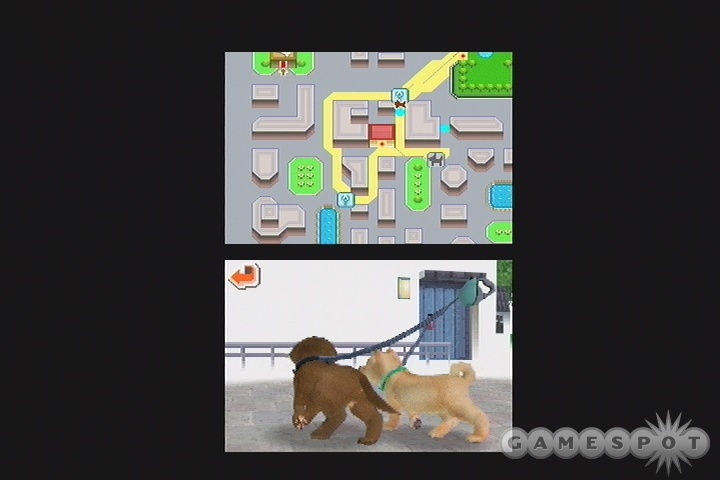
When your dog meets up with another dog, a few things can happen. In most cases, the two dogs will start out by barking at you while you desperately hit on the other dog's owner. There's precious little you can really do to influence your dog's behavior here, but you can move the leash around to goad your dog into approaching the other dog if you wish. The two dogs may eventually settle down and get friendly with each other by nuzzling, or just keep barking until it's time to go, or actually start fighting by lunging and attempting to flip each other over.
In general, it's worth waiting around when you meet another dog to see what happens. If the dogs get friendly, your dog will feel better about himself; if they remain curious about each other (indicated by nonstop barking), then no harm done. If they start to fight, though, you'll probably want to break them apart by clicking on the back arrow and leaving the dog in the dust.
Landmarks
In addition to just wandering aimlessly, you can also visit new buildings while you're out and about on your walk. There are a couple of parks near your house, as well as discount shops and a gym which can be used to train your dog for agility contests.
The parks here are going to be useful for training your dog for the disc competition, or just to get it out for some company with other dogs. There are two parks in the neighborhood, one empty and one with a couple of dogs playing in it. Note that the dogs move from park to park, so if one's empty one day, it might be full the next! Disc training is best at the empty park, but playing around with the other dogs at the full park can be amusing as well, especially with items like the pull rope which more than one dog can use at the same time.
The gym (there's only one of them) will be represented by a building with an icon of a dog jumping over a hurdle on it. If you visit the gym, then you'll be able to put your dog through the ringer and mercilessly belittle it until it finally learns how to jump over a hurdle. There are also hoops coated with flame, but you won't be able to access those until you're ready to sell your dog to the circus.
The discount shops are a bit too distant to walk your dog to when you first get one, but over time, you'll be able to reach them, and you'll be glad when you can. Although the main shopping area that's available from the "Go Out" menu offers everything you absolutely need to take care of your dog, the discount shops will have many of the same items at much cheaper prices, as well as odder items like keyboards, new accessories, or other surprising items. The inventory of the discount shops changes over time, so be sure to visit them whenever possible to find new stuff!
Disc Training And Competition
Training For Discs
The disc competition is one of the three main areas of competition for your dog, and arguably the easiest. After you obtain a plastic disc to throw to your dog, you can train it in the park or in your home, then bring it to competitions to earn moolah.
When you get a disc, you'll have to train your dog both to catch it and to bring it back to you when they grab it. It's easiest to do this in one of the parks, which you can reach when you take your dog out for a walk. There are two parks near your house, one of which will have a couple of dogs in it, and one which will be empty. You'll be able to know which is which by looking at them on the map; the one with dogs in it will, oddly enough, have a pair of dog icons on it. For the purposes of disc training, the other dogs will be a bit of a distraction to your dog, so head for the empty park to get some good one-on-one time in.
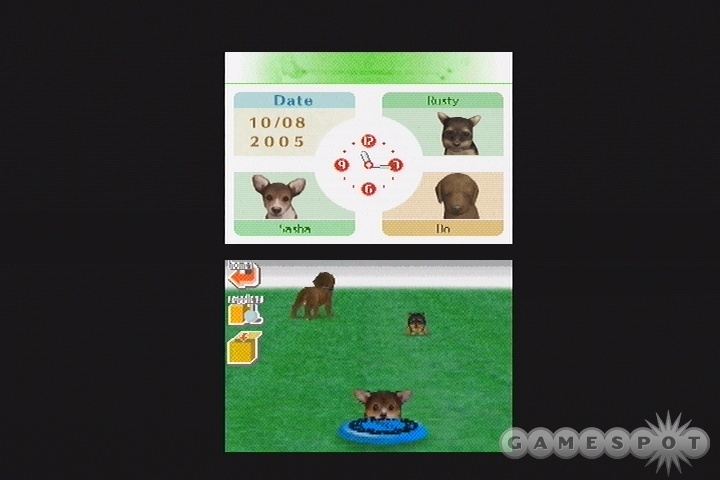
When you arrive at the park, bust out your disc and start throwing! In order to give your dog the best chance to catch the disc, you can't throw it too hard, or it'll fly faster than they can run and it'll drop to the ground; in a competition, this will result in zero points. It's also best to throw it as straight as possible. To do this, grab the disc, hold it near the bottom center of the screen, then move your stylus straight up towards the top before letting go. Varying your speed will affect the speed of the disc, so try to get a good smooth stroke without launching the thing into orbit. After a while you'll start to get a feel for how far you can throw it and still give your dog a chance to actually catch it.
After your dog retrieves the disc, it'll initially just play with it and whip it around in its mouth instead of returning to you. You can ask it to return by double tapping on the touch screen, which should get its attention. When it does finally bring the disc back to you, pet it. Rub that little noggin until you get the satisfaction stars popping off; doing so will train it to bring it back to you automatically, instead of being forced to call the pup every time it catches the disc.
Disc Competitions
If your dog's good at disc training, then it should be fine to take into competition, at least at the lower levels of competition. You have sixty seconds to work with here, and you'll be given points each time your dog successfully catches a thrown disc. You'll get more points the farther you throw the disc, and you get a bonus if your dog manages to execute a jumping catch.
If you've trained your dog in the park, then getting it to catch a frisbee shouldn't be overly difficult; just make sure you don't try and stretch its range too much, or it'll have a hard time getting to the disc before it falls to the ground, and if a disc hits the ground without being caught, you get zero points for it. A good amount of practice will be required before you get a feel for how far you can throw the disc without overextending your dog's reach, but when you get into a comfort zone, you should be able to pull off multiple jumping catches within the 60 seconds allotted to you. Of course, the more difficult the competition, the more points you'll be expected to score if you want to take first place, so do your best to reinforce your training by taking your dog to the park.
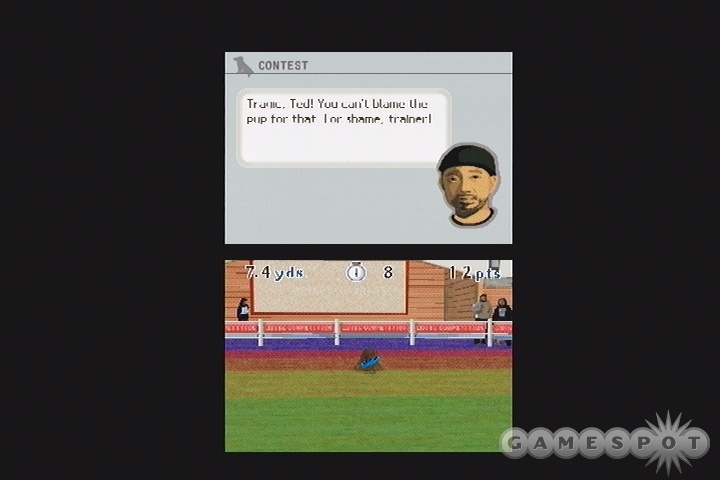
As you get towards Championship difficulty, you'll find yourself having to achieve 45 or 50 points within 60 seconds in order to get first place. In order to reach these marks, you're going to have to get all the way to the blue zone of the board consistently and quickly; a jumping leap here will net you 10 points. This requires a good amount of practice to hit, though, due to the fact that the park isn't labelled for competition distances. You may have to shuffle yourself up and down a bit between the various difficulties as you try to figure out precisely how to throw your disc so that it winds up in the blue zone of the field, without going too quickly for your dog to catch. Luckily, your dog should speed up as you continue practicing in the park, so you'll hopefully be fit for competition by the time you reach the upper echelons of the contest.
Lastly, keep in mind that time won't run out until you complete your last throw, or if the disc falls to the ground. Thus, if you get the disc back with a couple seconds left, you'll probably have enough time to throw it one last time; if time runs out while the disc is in midair, your dog will still be able to catch it for points. Kind of like sudden-death overtime.
Agility Training And Competition
The second kind of competition are the agility trials, which focus on your puppy's ability to navigate an obstacle course.
Training Agility
Like disc throwing, you'll need to take your dog for a walk if you want to train it for agility competitions. Instead of heading to a park, though, head to the gym. It's likely going to be a bit further away from your house than the parks are, though, so you may need to wait a little while before you can reach it. The gym is indicated by an icon of a dog jumping over a hurdle.
When you can make it to the gym, it's time to start working on those abdominal pecs and pectoral abs and whatnot. You'll find that the gym is going to be full of obstacles, with a couple showing up initially, and more to follow as the challenges get more and more difficult. Your dog will initially be fairly clumsy when it comes to navigating the obstacles, but it doesn't matter too much when you're in the gym; it's better to be clumsy there than be clumsy when you're in the middle of a competition. You have five primary obstacles to clear here.
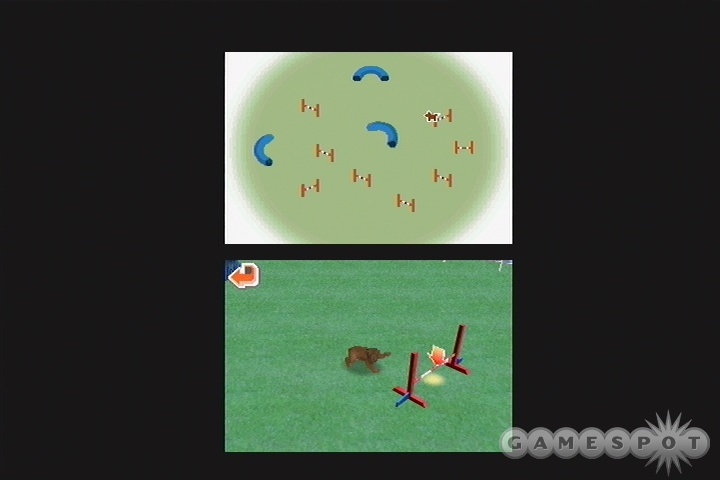
Hurdles: Hurdles are basically low poles that your dog has to jump over. To get your dog to jump a hurdle, click on the hurdle, wait for your dog to get close to it, then either drag the arrow to the far side of the hurdle or just click on the ground on the opposite side of the hurdle, and the dog will eventually jump over it. Some dogs are skittish around hurdles when they first encounter them, so you may need a bit of coaxing before your dog will jump. If the dog jumps too soon, it'll likely knock the pole to the ground, or actually land before it even reaches the hurdle, resulting in a miss. Misses will dock your points in a competition, so you'll want to keep your dog running at these hurdles until it feels comfortable with them!
Tunnels: Tunnels are the next kind of obstacle you'll face. These are just, well, long plastic tunnels that your dog will have to crawl through. This is pretty simple to do; just tap the end of the tunnel, wait for your dog to get inside, then drag the arrow through the rest of the tunnel at your dog's walking speed. It shouldn't have any trouble getting through.
Seesaw: Seesaws begin to appear after you win a competition or two. Tap on one end of them to get your dog onto it, then drag or tap the stylus up to the middle of the seesaw to keep it moving. When the seesaw starts tipping to the far side, tap behind your dog to get it to stop, and wait for the far end of the seesaw to hit the ground, then continue moving the dog along. If you don't pause the dog, it's likely to lose its footing and fall off the seesaw.
Double Hurdle: The double hurdle is just two hurdles set close together. If your dog has gotten good at normal hurdles, then your handling of these should be familiar, but you'll need to be sure that your dog approaches from a good angle. If possible, try to get your dog to approach from head on to ensure that it can jump over both of the hurdles without tripping one. These are more difficult than we're making them sound, though, as the longer distance of the jump requires you to really hit these dead on and get a good length of a jump before you're able to clear them.
Slalom: After a hard day in the competition circuit, all a dog really wants is to hit the river in their undersized kayak and try to maneuver through the challenging slalom course that Nintendogs has set up for them. Just be sure your dog doesn't mind getting wet before you attempt a slalom, or they'll have a hard time with this challenge.
Oh, ok, you got us: there's no water involved in this trick, however incredible that might've been. Instead, the slalom is a collection of poles sticking up out of the ground. In order to clear one of these obstacles, you'll need to guide your dog through the poles so it passes one on the left, the next on the right, and so on and so forth. This will require a lot of tapping with your stylus at first, as you'll have to encourage your dog to move through the poles in the proper manner, by tapping on alternating sides of the slalom. As with all of the obstacles, your dog will eventually get better at maneuvering these, and will be able to go through more quickly with less guidance from you.
Agility Competitions
Agility competitions are almost exactly the same as the agility training sessions, save for a few caveats. For one thing, you'll be asked to go through the obstacles in a certain order. For another, you'll be penalized points if you happen to miss an obstacle or mess up the trick associated with it; knocking the pole off of a hurdle, for instance, will net you a five point penalty. Lastly, you'll have a time limit as well; if you go over this limit, you'll be penalized for each second over the limit you go.
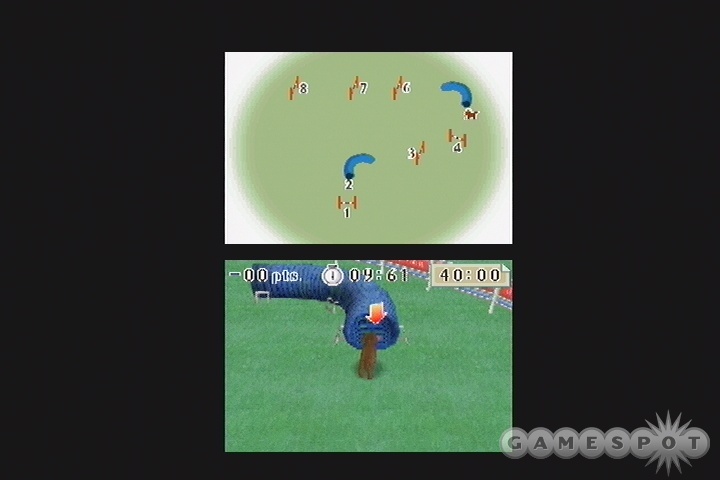
In order to score well in agility competitions, you have to pay attention to your top screen for once, as it will display a map of what order you have to take the obstacles in. If you proceed in any order you feel like, you'll rack up faults at a pretty rapid clip. Faults are basically point penalties that accrue when you don't complete an obstacle, make a mistake (such as falling off a seesaw or knocking a pole off a hurdle), or run over the time limit.
You can't actually increase your score in the agility competition, as such; you can really only hurt yourself by messing up. It is possible to run a perfect round by completing all of the obstacles without going over the time limit, in other words. If two dogs both run a perfect round, then the time will be the tiebreaker here; the dog that finished more quickly will be the winner. In general, it's best to go for accuracy instead of speed (if you have to make a compromise); finishing a perfect run a bit more slowly is usually going to be better than a speedy finish with a fault or two. When you get to the higher levels of competition, you won't be able to get away with a slow run or any mistakes, however, so you'll want to take your dog to the gym a number of times until it manages to hit every trick without mistake. Eventually, though, most dogs get really good at running the agility trials and will be able to do some of the simpler tricks with almost no input from you.
Obedience Competitions
The third and most difficult competition is the obedience competition. This will test your dog's ability to do tricks and, more crucially, to hold them for a set amount of time. Before you take your dog out to the obedience competition, be sure to check the trick list and have your dog learn as many of the basics as possible, as well as a few of the advanced tricks, as well, if you're going for a higher difficulty.
Obedience Training
There's no special place you have to take your dog to train it for obedience; you're going to be doing most of the training in your own home, when you teach it tricks. To prepare a dog for obedience competitions, then, you're going to want to have it learn as many tricks as possible, but also learn them well, which, for competition purposes, means that the dog can "hold" a trick, i.e. stay in that trick's position, for a good amount of time.
If you intend to go up to higher difficulty levels in the obedience contest, then be sure to have all of the basic tricks memorized, and be sure that your dog can pull them off without much trouble in response to your voice command. You'll also need to have a few of the advanced tricks memorized, with the more the merrier. Although you won't be asked to perform any advanced tricks in competition, they'll still be important to perform in the free performance section of a competition to boost your score.
Obedience Competitions
When you bring your dog to an obedience competition, you'll have to proceed through three types of stages, and you'll be scored in each. These stages are free performance, trick sequences, and holding.
Trick sequences are generally going to be the easiest sections of a competition if your dog is happy and has learned most of the basic tricks. In this section, the judges will give you three tricks to perform in order. You'll need to get these off in the order required if you want to get a high score from the judges. You can still get a decent score for pulling off the first two tricks in a sequence, but if you want a high score you'll obviously want to do all three, in the correct order.
Free performance lets your dog shed its inhibitions and finally get footloose. During these sequences, you'll have a set amount of time in which to perform any tricks you like in order to impress the judges. This is where you want to bust out your advanced tricks, if you think your dog has learned them well! Be sure to vary your tricks up to earn high scores.

Holding is one of the most difficult parts of the obedience contest, especially at higher levels of competition. It sounds simple - all your dog needs to do is perform a trick, then hold it for a set amount of time. At the lower difficulties of competition, you're going to need to hold a trick for three or four seconds at a time, but by the time you hit the championship round, you'll need to hold tricks for 15 or 20 seconds at a time!
In order to practice your holding, all you can really do is try to repeat the basic tricks over and over again with your dog. Repetition will allow it to hold the poses for a good length of time, so you'll just need to perform a command, watch the dog perform it, then pet it when it finally breaks off and starts walking around again.
If your dog is well-trained and likes you a lot, then you shouldn't have many problems getting through the lower difficulties of the obedience competitions. Moving higher will require greater obedience from your dog, and you'll have to enter a competition with it in a good mood if you want to excel. To that end, be sure to feed it and give it something to drink before heading into a competition, and be absolutely sure to give it a shampoo and a good brushing-down. A beautiful coat of hair will not only make your dog feel better about itself, but will also impress the judges and slightly boost your scores.
Got a news tip or want to contact us directly? Email news@gamespot.com
Join the conversation